1.e4 e6 2.d4 d5 3.e5 b6!? 4.Bb5+!?
I recognized this exact sequence from a game I'd recently played through (Shabalov vs. Seirawan, U.S. Championship, Chandler, Ariz., 1997), and for the next several moves allowed myself to be guided by the spirit of Seirawan.
4...c6 5.Ba4 b5 6.Bb3 c5 7.c3 Ne7 8.a3
Jim finally stops playing like Shabalov, but I keep following Seirawan's strategy.
8...Nec6 9.Be3 Nd7 10.Nf3 h6 11.0-0 c4
I'm loving my space advantage right now. Jim is squirming.
12.Bc2 a5
Preparing to push my b-pawn.
13.Bd2
Jim could have played 13.Nfd2, making it dangerous for me to take away the c4-pawn's cover.
13...Bb7 14.b3 Nb6 15.Qe2 b4 16.a4
The move I've been setting up for all this time. Yet, according to Fritz, I could have gained a larger advantage with 16...cxb3 17.Bd3. White can't retake on b3 because of the skewer threat 17...Ba6. I need to be more ambitious.
17.Bxc3 Ba6 18.bxc4 Bxc4 19.Bd3 Bxd3 20.Qxd3
So why is it still an even game?
Maybe because I forgot a basic strategic principle: Trading pieces helps the player with less space to maneuver. Now a lot of the pressure I had on Jim has been relieved.
Plus, having done what I came to do, I'm not sure what to do next, as the following move shows.
20...Nc4?! 21.Nbd2
The balance of power begins to shift in Jim's favor.
21...Nb4 22.Bxb4 Bxb4
Now I begin to realize that I haven't read this sequence out, and it ends with me down a pawn and Jim's queen threatening to fork me. Erp.
23.Nxc4 dxc4 24.Qxc4
With the fork threat 25.Qc6+.
24...Qd5?!
This move isn't even in my top five. Best was probably 24...Rc8, pointing a big gun in the interloper's face, but simply castling would have worked, too. I think maybe I was getting greedy and hoping to grab my pawn back.
25.Qxd5 exd5 26.Rfd1 Rc8 27.Nd2 Bc3
There were better ideas than this -- for instance, trading off bishop for knight, pushing my rook to Jim's third rank, or simply getting my king off the back rank so that my rooks would be connected. I recall balking at the trade because I was a pawn down and worried that I wouldn't be able to swing the endgame without the slight advantage of having a bishop against a knight. But 27...Bxd2 28.Rxd2 Rc4 is most unneighborly: it keeps both of white's rooks tied up protecting pawns.
28.Rab1 Bxd4 29.Rb5 Bxe5?
This is just not smart: it sets up the pin 30.Re1. Lucky for me, Jim missed it.
30.Rxd5 Bc7 31.Re1+ Kf8
Jim was feeling positively gleeful now. My failure to castle earlier allowed him to stuff my king in the corner, along with an undeveloped rook.
32.Ne4 g5 33.g3 Bb6 34.Nf6 Rd8??
Gives white the nasty attacking chance 35.Nd7+.
35.Rxd8+??
Whooooops. This move takes all the steam out of Jim's attack.
35...Bxd8 36.Re8+ Kg7 37.Nh5+ Kh7 38.Rxh8+ Kxh8
And the attack fizzles out. Now what?
39.f4 f6
I offered Jim a draw here, but he declined it.
40.f5 Kg8 41.g4 Kf8 42.h3 Ke8
I didn't play 42...Ke7 because my bishop was guarding the f6-pawn, and I didn't want to block it. It should have dawned on me that for the one move the king would block the bishop's protection, it would provide protection itself. Sigh.
43.Ng7+ Kd7 44.Ne6 Bb6+ 45.Kf1
Now that I'm checking it, Jim is finally moving his king. Maybe I should have left well enough alone.
45...Kd6 46. Ke2
Crap. That knight is disrupting my king's path to a4. If I move 46...Kd5, 47.Kd3 keeps me out of white's territory. Time for a change of plan.
46...Ke5 47.Kd3
Grrr! My plan was a bad one! The knight also blocks my path to g3! Actually, the plan was fine. We're just in a standoff.
47...Kd5 48.Kc3 Be3
I offered Jim the draw again, and again, he turned it down.
49.Nd8
49...Bb6?
Uh-oh. Houston, we have a problem. 50.Nf7 threatens to take out one of my backward pawns, and the only way to prevent it was 49...Bc5, followed by 50...Bf8. It's not looking drawish anymore.
50.Nf7 Bc7 51.Nxh6 Be5+ 52.Kb3 Bg3 53.Ng8 Be5 54.Ne7+ Kc5 55.Ng6 Bd4 56.Nf8
Jim passes up an opportunity to trade pawns with 56.h4 gxh4 57.Nxh4. Instead, he threatens a fork on d7 (or e6, if I don't get my bishop out of the way).
56...Kd6??
Makes both fork possibilities moot . . . but also yields ground to Jim's king. According to Fritz, 56...Ba1 and 56...Kd5 were the only moves worth considering. Jim now has a deadly rejoinder: 57.Kc4 gains a tempo by threatening my bishop, then 58.Kb5 takes the bishop out of the game by tying it down to the defense of a5.
57.Ne6 Bb6?
57...Kd5 would have kept white's king from advancing.
58.Kc4 Kc6 59.Nf8 Bc5 60.Ne6 Bb6 61.Ng7 Bc5 62.Nh5 Be7
Jim and I are both walking a tightrope . . .
63.Ng3 Bd6 64.Ne4 Be7 65.Nc3 Bb4??
. . . and I fall off.
66.Nd5! 1-0
Ow.

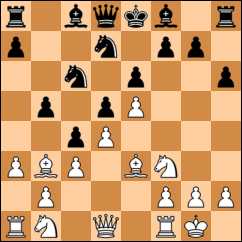
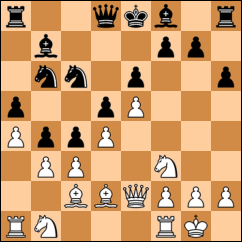
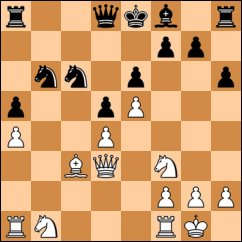
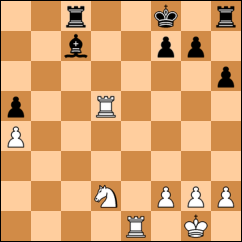
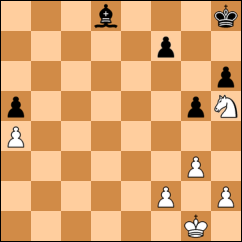
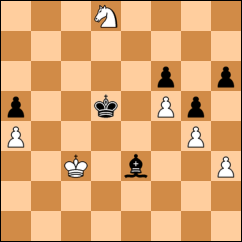
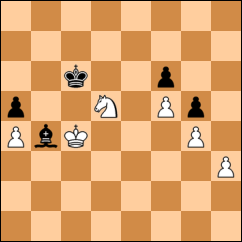



0 comments:
Post a Comment